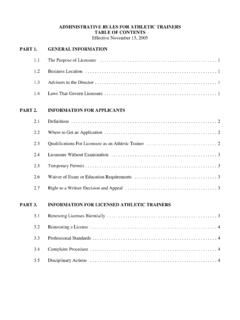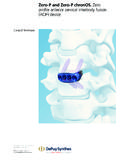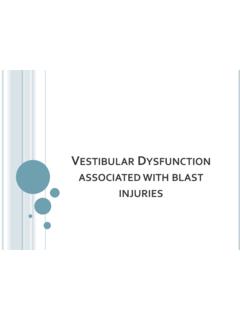Transcription of l nnua 5 h A 2 Dynamic Stability t of the - NATA
1 National Athletic Trainers Association 56thAnnual Meetingand Clinical Symposia, June 2005 Dynamic Stability of the cervical SpineNational Athletic Trainers Association 56thAnnual Meetingand Clinical Symposia, June 2005 Anatomical ConsiderationsBony configuration (biomechanics)Bony configuration (biomechanics)Muscles (neuromuscular)Muscles (neuromuscular)Accompanying structures (kinetic chain) Accompanying structures (kinetic chain) National Athletic Trainers Association 56th Annual Meetingand Clinical Symposia, June 2005 cervical VertebraeC1C2 National Athletic Trainers Association 56th Annual Meetingand Clinical Symposia, June 2005 Spinal VertebraeLumbar SpineThoracic SpineCervical SpineNational Athletic Trainers Association 56th Annual Meetingand Clinical Symposia, June 2005 Neurological Considerations9 Extensive Wiring9 Extensive Mechanoreceptor and proprioceptive networking9 Multiple sources for PAINN ational Athletic Trainers Association 56th Annual Meetingand Clinical Symposia.
2 June 2005 Neurological ConnectionsNational Athletic Trainers Association 56thAnnual Meetingand Clinical Symposia, June 2005 MusculatureNational Athletic Trainers Association 56th Annual Meetingand Clinical Symposia, June 2005 Anterior cervical SpineDeep cervical Flexors = Vertebral Flexors (local) spine Flexors (global)Longus ColliNational Athletic Trainers Association 56th Annual Meetingand Clinical Symposia, June 2005 Anterior cervical SpineDeep cervical Flexor MusclesLongus Colli & Capitis (intervertebral) Superficial Flexor MusclesNational Athletic Trainers Association 56th Annual Meetingand Clinical Symposia, June 2005 Posterior SpineU.
3 Trapezius & Levator Scauplae tether National Athletic Trainers Association 56th Annual Meetingand Clinical Symposia, June 2005 Kinetic Chain ImplicationsInterfacing with: Rib CageScapulaGHJ FunctionAnterior LoadingOfC- spine withShoulder GirdleNational Athletic Trainers Association 56th Annual Meetingand Clinical Symposia, June 2005 Shoulder Girdle Dyskinesis9 Scapulo-humeral Rhythm9 Rib Cage9 GHJ Function Link to:9 Upper Extremities9 The Lumbar SpineNational Athletic Trainers Association 56th Annual Meetingand Clinical Symposia, June 2005 Force Closure9 Spinal Stability9 Core Stability9 Lower Extremity InfluencesVleeming, et al.
4 Spine20 (7), 1995 Janda s Pelvic Crossed SyndromeNational Athletic Trainers Association 56thAnnual Meetingand Clinical Symposia, June 2005 Spinal StabilityPanjabi, M. M. (1992). The stabilizing system of the spine . Part I. Function, dysfunction, adaptation, and enhancement. Journal of Spinal Disorders, 5(4), 383-389 Panjabi, M. M. (1992). The stabilizing system of the spine . Part II. Neutral zone and instability hypothesis. Journal of Spinal Disorders, 5(4), 390-397 National Athletic Trainers Association 56th Annual Meetingand Clinical Symposia, June 2005 spine Stabilization Neural SubNeural Sub--SystemSystem Controls active & passive subControls active & passive sub--systemssystems Feedback mechanismsFeedback mechanisms Force transducersForce transducers in ligaments, muscles, in ligaments, muscles, tendons & neural control centerstendons & neural control centers Compensates to maintain Stability Compensates to maintain Stability .
5 Of the ..of the systemsystem May compromise locally for global stabilityMay compromise locally for global Stability Resultant tissue and joint degeneration, Resultant tissue and joint degeneration, abnormal muscle loads, fatigue, muscle loads, fatigue, Athletic Trainers Association 56th Annual Meetingand Clinical Symposia, June 2005 spine Stabilization - cont Passive SubPassive Sub--SystemSystem VertebraeVertebrae Facet articulationsFacet articulations IntervertebralIntervertebraldiscsdiscs Spinal ligamentsSpinal ligaments Joint capsulesJoint capsules Passive mechanical Passive mechanical properties of the properties of the musclesmuscles Active SubActive Sub--SystemSystem Muscles & tendonsMuscles & tendons Surrounding spinal Surrounding spinal columncolumnNational Athletic Trainers Association 56th Annual Meetingand Clinical Symposia.
6 June 2005 Neutral spine the posture of the spine in which thethe posture of the spine in which the overall internal stresses in the spinal overall internal stresses in the spinal column andcolumn and the muscular effort to hold the posture arethe muscular effort to hold the posture are minimalminimal What does that look like clinically??What does that look like clinically??National Athletic Trainers Association 56th Annual Meetingand Clinical Symposia, June 2005 Functional Zones Neutral ZoneNeutral Zone Minimal internal resistanceMinimal internal resistance Elastic ZoneElastic Zone End of the neutral zone up to the End of the neutral zone up to the physiological limitphysiological limit Note: repeated physiological loadingNote.
7 Repeated physiological loading Residual displacement of tissueResidual displacement of tissueNational Athletic Trainers Association 56th Annual Meetingand Clinical Symposia, June 2005 Clinical Implications Displacement beyond the neutral zone due to Displacement beyond the neutral zone due to compensation would result in damage, compensation would result in damage, degeneration, abnormal muscle loads and muscle degeneration, abnormal muscle loads and muscle fatigue fatigue Spinal ROM that is typically measured clinically, Spinal ROM that is typically measured clinically, encompasses the available displacement from both encompasses the available displacement from both the neural & elastic zonesthe neural & elastic zones The current The current clinicalclinicalmodel is insensitive to onmodel is insensitive to on--going physiological adaptation & damage and that going physiological adaptation & damage and that when changes in spinal ROM are seen clinically, when changes in spinal ROM are seen clinically, irreparable damage may already be done.
8 Irreparable damage may already be done, precluding prevention intervention strategiesprecluding prevention intervention strategiesNational Athletic Trainers Association 56th Annual Meetingand Clinical Symposia, June 2005 Putting It All Together:The Game Plan Local Intervention: cervical spine Local Intervention: cervical spine Deep cervical flexor activationDeep cervical flexor activation SuboccipitalSuboccipitalmobilitymobility Global InterventionGlobal Intervention PosturePosture Thoracic SpineThoracic spine Shoulder GirdleShoulder Girdle Scapula stabilizationScapula stabilization Core StabilityCore Stability LocalLocal GlobalGlobal Form & Force closureForm & Force closure Secondary considerations of the Lower ExtremitySecondary considerations of the Lower Extremity Pelvic InclinationPelvic Inclination Foot MechanicsFoot MechanicsNational Athletic Trainers
9 Association 56th Annual Meetingand Clinical Symposia, June 2005 Muscle Impairment Diminished Deep cervical Flexor ActivityDiminished Deep cervical Flexor Activity Delayed onset of neck muscle contraction with Delayed onset of neck muscle contraction with associated movement of the upper limbassociated movement of the upper limb Increased superficial cervical flexor muscles Increased superficial cervical flexor muscles during functional activitiesduring functional activities Increased fatigability of cervical flexors in neck Increased fatigability of cervical flexors in neck pain patientspain patientsFalla, D.
10 ,Manual Therapy, 9:125-133, 2004 Falla, et al, Clinical Neurophysiology 114:488 495, 2003 National Athletic Trainers Association 56th Annual Meetingand Clinical Symposia, June 2005 Feedforward Activation with Upper Extremity Movement SCM & cervical ExtensorSCM & cervical Extensor CoCo--contractioncontraction Within 50 ms of Within 50 ms of Deltoid OnsetDeltoid Onset Automatic Automatic feedforwardfeedforwardresponse delayed in response delayed in chronic neck pain chronic neck pain subjectssubjects TransversusTransversusAbdominisAbdominis FeedforwardFeedforwardactivation activation with all GHJ motionswith all GHJ motionsHodges and Richardson, Hodges and Richardson, Exp Brain Exp Brain ResRes, 114:362, 114.
















